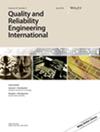Bayesian estimation of the mean time between failures of subsystems with different causes using interval‐censored system maintenance data
IF 2.8
3区 工程技术
Q3 ENGINEERING, INDUSTRIAL
引用次数: 0
Abstract
Ensuring an acceptable level of reliability stands as a primary imperative for any mission‐focused operation since it serves as a critical determinant of success. Inadequate reliability can lead to severe repercussions, including substantial expenses for repairs and replacements, missed opportunities, service disruptions, and in the worst cases, safety violations and human casualties. Within national defense organizations such as the USAF, the precise assessment and maintenance of system reliability play a pivotal role in ensuring the success of mission‐critical operations. In this research, our primary objective is to model the reliability of repairable subsystems within the framework of competing and complementary risks. Subsequently, we construct the overall reliability of the entire repairable system, utilizing day‐to‐day group‐censored maintenance data from two identical aircraft systems. Assuming that the lifetimes of subsystems follow non‐identical exponential distributions, it is theoretically justified that the system reliability can be modeled by homogeneous Poisson processes even though the number of subsystems of any particular type is unknown and the temporal order of multiple subsystem failures within a given time interval is uncertain due to interval censoring. Using the proposed model, we formulate the likelihood function for the mean time between failures of subsystems with different causes, and subsequently establish an inferential procedure for the model parameters. Given a considerable number of parameters to estimate, we explore the efficacy of a Bayesian approach, treating the contractor‐supplied estimates as the hyperparameters of prior distributions. This approach mitigates potential model uncertainty as well as the practical limitation of a frequentist‐based approach. It also facilitates continuous updates of the estimates as new maintenance data become available. Finally, the entire inferential procedures were implemented in Microsoft Excel so that it is easy for any reliability practitioner to use without the need to learn sophisticated programming languages. Thus, this research supports an ongoing, real‐time assessment of the overall mission reliability and helps early detection of any subsystem whose reliability is below the threshold level.用贝叶斯方法估算不同原因子系统故障的平均间隔时间(使用区间校验的系统维护数据
确保可接受的可靠性水平是任何以任务为中心的运行的首要任务,因为它是决定成败的关键因素。可靠性不足会导致严重后果,包括维修和更换的巨额费用、错失良机、服务中断,最严重的情况下还会导致违反安全规定和人员伤亡。在美国空军等国防组织中,系统可靠性的精确评估和维护对确保关键任务的成功执行起着举足轻重的作用。在这项研究中,我们的主要目标是在相互竞争和互补的风险框架内建立可修复子系统的可靠性模型。随后,我们利用来自两个相同飞机系统的每日组删减维护数据,构建了整个可修复系统的总体可靠性。假定子系统的寿命遵循非同指数分布,那么即使任何特定类型的子系统数量未知,并且由于时间间隔删失,给定时间间隔内多个子系统故障的时间顺序不确定,系统可靠性仍可由同质泊松过程建模,这在理论上是合理的。利用所提出的模型,我们提出了不同原因子系统故障平均间隔时间的似然函数,并随后建立了模型参数的推断程序。鉴于需要估计的参数数量相当多,我们探讨了贝叶斯方法的有效性,将承包商提供的估计值视为先验分布的超参数。这种方法缓解了潜在的模型不确定性以及基于频数法的实际局限性。它还有利于在获得新的维护数据时不断更新估计值。最后,整个推论程序都是在 Microsoft Excel 中实现的,因此任何可靠性从业人员都可以轻松使用,无需学习复杂的编程语言。因此,这项研究支持对整个任务的可靠性进行持续、实时的评估,并有助于及早发现可靠性低于临界值的任何子系统。
本文章由计算机程序翻译,如有差异,请以英文原文为准。
求助全文
约1分钟内获得全文
求助全文
来源期刊
CiteScore
4.90
自引率
21.70%
发文量
181
审稿时长
6 months
期刊介绍:
Quality and Reliability Engineering International is a journal devoted to practical engineering aspects of quality and reliability. A refereed technical journal published eight times per year, it covers the development and practical application of existing theoretical methods, research and industrial practices. Articles in the journal will be concerned with case studies, tutorial-type reviews and also with applications of new or well-known theory to the solution of actual quality and reliability problems in engineering.
Papers describing the use of mathematical and statistical tools to solve real life industrial problems are encouraged, provided that the emphasis is placed on practical applications and demonstrated case studies.
The scope of the journal is intended to include components, physics of failure, equipment and systems from the fields of electronic, electrical, mechanical and systems engineering. The areas of communications, aerospace, automotive, railways, shipboard equipment, control engineering and consumer products are all covered by the journal.
Quality and reliability of hardware as well as software are covered. Papers on software engineering and its impact on product quality and reliability are encouraged. The journal will also cover the management of quality and reliability in the engineering industry.
Special issues on a variety of key topics are published every year and contribute to the enhancement of Quality and Reliability Engineering International as a major reference in its field.

 求助内容:
求助内容: 应助结果提醒方式:
应助结果提醒方式:


